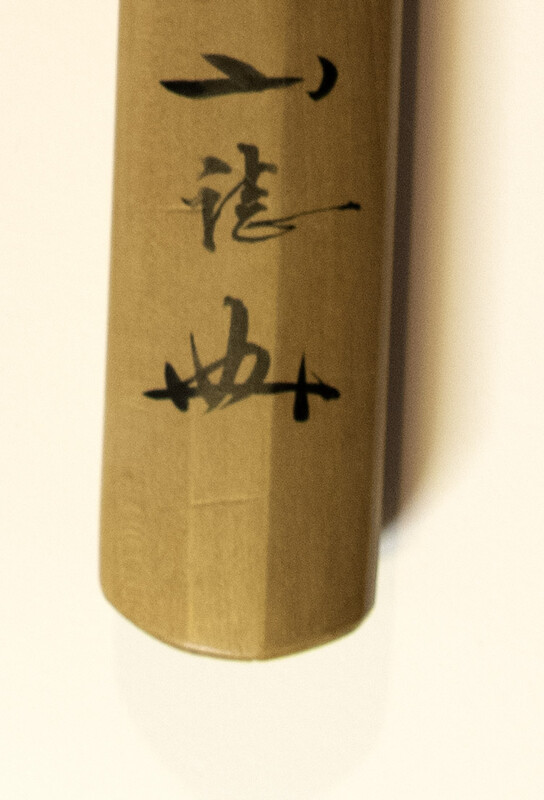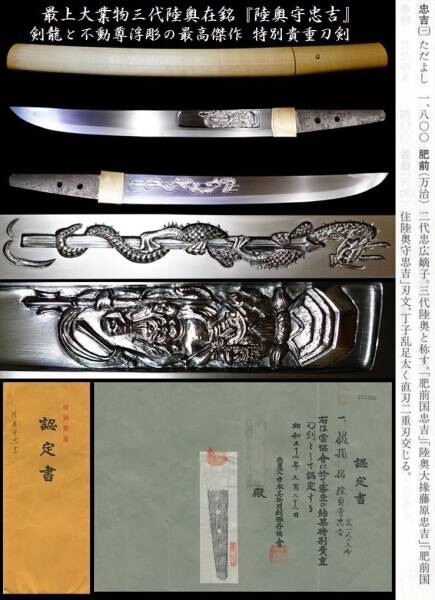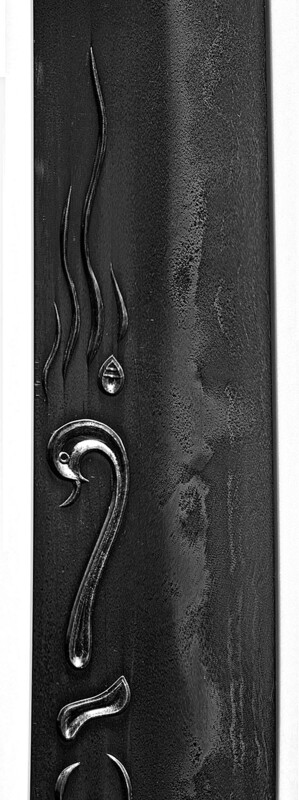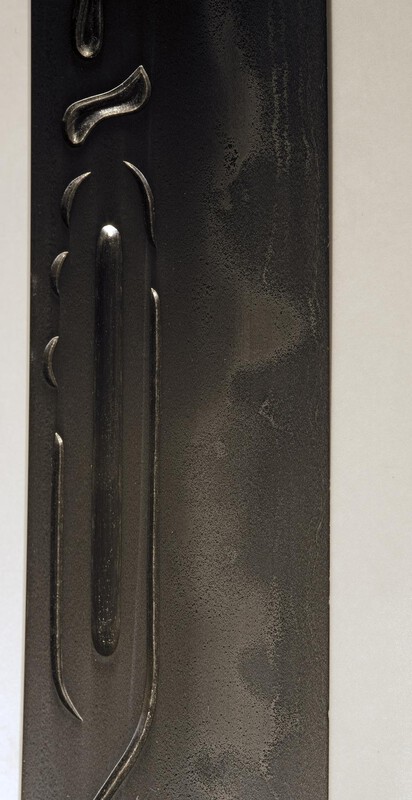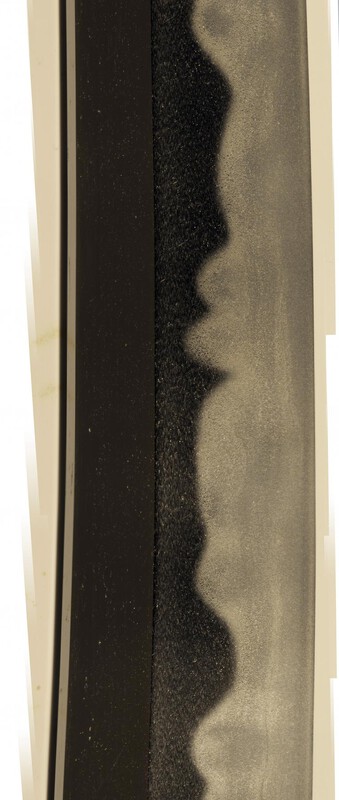-
Posts
2,288 -
Joined
-
Last visited
-
Days Won
19
Content Type
Profiles
Forums
Events
Store
Downloads
Gallery
Everything posted by Rivkin
-

Discrepancy between sayagaki and 著名家刀...
Rivkin posted a topic in General Nihonto Related Discussion
One thing that puzzles me is how few blades with sayagaki to Daimyo collections have actual reference to the list in 著名家刀剣目録 単行本 or similar two volume publication. Is it because sellers are sort of "lazy" to find the actual reference for their sayagaki/"Daimyo torokusho", or its basically a vain attempt because the list itself is very much incomplete? Thank you! Kirill R. -

Accidental Autograph Collector Kanzan Sato
Rivkin replied to Surfson's topic in General Nihonto Related Discussion
Thank you! Its hard for me to claim expertise on the intent and procedure that was in place, since unlike Andy Quirt and quite a few older generation's representatives I was not there. All I can observe right now is being on the receiving end of these opinions. I feel that they were somewhat popular in the interwar period, since that was how the blades were judged - and most of those are kind of worthless today unless they provide a direct provenance to older collection. Basically even the most experienced people at the time had limited access to top blades and were dominated by pre-Meiji appraisals, so the opinions can be random. The desire for sayagaki truly awoke again only in the late 60s, when blade market was beginning to strive, and for some reason probably more so than now it was felt that green papers are not enough, so a lot of blades were given a sayagaki. Honami Nishu at best worked with questionable ko-mihara Juyos from 21-27th sessions, and almost half of his sayagaki will not paper today the same. Appraisals sort of close, but substantially different, for example what papers as Edo Sendai sayagakied to Yamato Hosho. It seems he was the person to be contacted till late 80s about things that were raising eyebrows. Dr. Honma Junji basically wrote sayagaki for blades like those published in the register of Daimyo treasures, which for some collectors kind of what needs to be collected. His appraisals are very seldom overturned, but they also have quite a few nuances to them. Dr. Sato wrote a very substantial portion of the total number of sayagaki. It might be that especially with the top names any papers were still not getting acceptance by themselves, so sayagaki was considered a must and he was the person to be asked. I think with some specific attributions like Muramasa there is a substantial chance that today's judgement standards will not confirm his appraisal - but it is just my personal observation. He also often gave benefit of the doubt to a traditional attribution, if it already existed. It does not go outside of realm of reasonable possibility, but there are cases when you get his sayagaki and green papers to say Sadamune and today it comes out as Shizu Kaneuji. Kirill R. -

Accidental Autograph Collector Kanzan Sato
Rivkin replied to Surfson's topic in General Nihonto Related Discussion
Thank you very much, it was kind to mention... I have to say that the reason I place so many articles on Japanese topics on my sites is because it is a current ongoing learning process, versus medieval Islamic or Caucasian, where earlier articles where already summarized in the last two books. Back to subject, from my database of auctions (which has some issues), from the total number of sayagaki: 46% by Dr. Kanzan Sato 9% by Tanobe Michihiro 3% by Dr. Honma Junji Among others Honami Nishu and Honami Koson are strongly represented. There is correlation with paper level. For example, I guess there was significant recent shift in Muramasa appraisal, so significant chunk of Dr. Sato sayagaki to him has green papers. Honami Nishu has a correlation to the smallest overall percentage of recent papers. Kirill R. -

Accidental Autograph Collector Kanzan Sato
Rivkin replied to Surfson's topic in General Nihonto Related Discussion
-
It is a very strange blade in many aspects. The condition of nakago is not a good fit for Muromachi, it looks later. The shape which is quite straight and has pronounced fumbari almost looks Keian to Manji, but it lacks typical shinto suguha in boshi. The signature is a decent match but the writing is somewhat weak, though hard to say with just these photos. Personal opinion it is gimei. Kirill R.
-
The signature is strange indeed as Ray mentioned in the way Bishu ju is omitted; also my personal feeling would be that Tadamitsu tend to fall into slightly earlier sugata - either long blades with long nakago and slight saki-zori or dating to 1500-1520 uchi-gatana with short-wide nakago. A personal feeling - this one seems slightly later. It certainly falls into uchi-gatana dimension size-wise, but the proportions are different. This being said, with multi-generation smiths from Sengaku deviations in signatures and work style, but seldom both simultaneously, are often accepted. I had little known smith with work sort of typical for the school, but the signature included names he was never known to have - and it papered, no one will argue that among the many generations there was not one who did not have these names, even if they are not in the books and even look very strange (wrong clan name). Slightly different story than here though. Kirill R.
-
Possible, but a few things: Very few swords were made beginning with 1700 due to economic collapse. Nakago condition and the lack of well defined filing more consistent with earlier date Lots of ware and other issues is also not that common in Kambun and later swords. I personally would not discard 1550 as possiblity. Kirill R.
-
Without looking at the signature, it kind of feels early Edo or maybe Momoyama. Kirill R.
-
It is quite hard to show a sword with exactly the same yasurime, hi, sugata, exactly this length of kissaki, and I have to admit that kantei by hi is way above my level. There are plenty of good horimono that do not repaper, this one I do (sort of) know. Meiji to Showa had some of the best cutters that ever existed. Kirill R.
-
There is no visible damage to its complex sugata so the chance of being burned is very low. Other than this, shinshinto and gendai are not known for widespread flaws. Maybe a tiny fukure, a short ware somewhere. Not something a window will tell, and unlikely something truly catastrophic. Even if it is (early?!) Kiyomaro, the chances of it having such a distinguished work that it can be judged by it alone - is low. If you collect koto, you study blades. If you collect Edo, you have to study signatures. Otherwise there are plenty of top name blades out there that in craft look 100% convincing, but will never paper because the signature has strange elements to it. Some in 1970s did get green papers, but today's Art world is much more paranoid. Would it still be worth its money if it polishes and does not paper? Maybe. If the work is good, it can be a decent Kiyondo. It can also be a dud someone made, lets say in Taisho era. It will be a fun project though and about a year of precious waiting and guessing "did I win the lottery", so that's by itself is probably worth a lot. Kirill R.
-
Potentially erroneous and highly personal take - signature will play >80% of the role in papering this blade. The best course is to show the photograph to someone who seriously deals with Kiyomaro collecting in Japan and see what the response is going to be. For pre-Muromachi blade signature might be in 10% of importance and even significant issues will be overlooked. There are quite a few Juyo where "people know" the signature looks strange and can be even Muromachi period add-on. There are very respected blades like Hojo's gifts where it can be theorized that the signatures were added around 1520 - and it does not really bother people except maybe those with more "historian" attitude. Its about 30% for Muromachi blades, but goes up to 70-95% for top names for anything from Edo period, except very few who are kind of known to be highly unique in their work. Mumei blades appraised to Sukehiro or Shinkai are exceptionally rare and bordering on non-existent for some judges. Bad signature on Kiyomaro cannot be broken (we accept that the smith had a cold and his hand wavered in second kanji...) by the blade's quality by itself, unless its close to the best blade Kiyomaro ever made. Otherwise no matter what one finds - shinshinto take on Soden Bizen, Soshu a-la-Norishige, Soshu a-la "Masamune", Bizen that tries to be more Ichimonji etc. etc., related things were sort of experimented on by others at the same time, and even at very good quality level it can theoretically be Kiyondo or a dozen of other shinshinto (and even later) smiths who worked within roughly the same Soshu-Bizen "area of interest" - and whose blade was then upgraded with a signature. Very few will take a risk to claim on paper it is Kiyomaro if there are doubts on the signature. Per current practice It will likely not be rejected, but the paper will not be issued, as "more research is needed". Kirill R.
-

Tanto with Rare Attribution
Rivkin replied to Vermithrax16's topic in Auctions and Online Sales or Sellers
Have to honestly admit I don't know from the hip about Asago-Taima school. Other than that to me later period Fujishima looks like typical Muromachi period Soshu (choji with sunagashi style, practiced almost everywhere at the time), maybe with a little bit more pronounced Norishige-imitation-like hada, and more coarse nie which extends further into ji. I would not be surprised that sayagaki were requested in hope that the attribution will be a somewhat higher name in Soshu. Kirill R. -
Where to begin... Mainline Goto Menuki which turned out to be a similar item, but clearly different in details from the one photographed in the attached papers. The worst by far however was a blade with very high papers, big name, sold at a considerable discount to what such papers tend to command - and a realization that is boring as hell. And obviously when trying to bring back to seller you are told that the sword market is extraordinary bad and well you had a great deal when bought it, but that was a week ago. Lesson learned - mid Kamakura Bizen/Fukuoka/etc in suguha with few exceptions, Heian in suguha, all those Ukai, Rai for me are in 99% of cases turn out to be boring, single day study swords, which also can easily be somewhat to Very tired even at the highest levels of paper kingdom, were they are also commonly encountered - and are almost of no value to me. In suguha I can enjoy Shintogo Kunimitsu, Ko Aoe, some Oei Bizen, sort of like Nosada or Hizen Tadayoshi and that's about it. For the rest comparing to Soshu or Hatakeda-Moriie everything looks pale, dim and basically boring. Really not that different from a non-Japanese 10th century sword in Japanese polish, if one fancies such experiments and has a highly uncommon access to very good condition examples. For me aside from the few schools, one can find funner, more artistic and if one desires - more bloodied things to collect in non-Japanese world at lower prices. So I learned that my preferences in nihonto are very narrow. Consequence - also learned that reliance on paper level in nihonto is also not a good fit for me. BTW general result - one learns on average more from unexpected (and often bad) experience compared to cases where everything goes as planned. Kirill R.
-
My very personal and erroneous take. 20s Juyo sessions are suspect in a sense of quite a few genuinely old blades of somewhat boring nature making it there. Rather ordinary looking Mihara and similar others, not to argue that the schools are bad, but what was passed was not outstanding. Regarding judgement, I feel Tametsugu ones tend to come with Den since he is portrayed as a unique smith who was Kaga, Echizen and Mino. So something completely out of bounds for Norishige, like well defined periodic choji, will not disprove Tametsugu attribution (lets just call it his Mino phase?). Which in turn makes him a little bit of a vacuum since wtih Den he can collect as attributions the works with a very wide range of features - and also his attributions sometimes jump to others when resubmitted. I don't think its really a downgrade, since because of sugata changes once its certain that the blade is circa 1350-1360 there are not that many available Soshu attributions. A lot of Tametsugu are Masamune and Norishige's from Edo period, that got caught into a big slide of scepticism, especially beginning with the 1990s. The attribution from 1970s that I find very many issues with is Takagi Sadamune. Maybe I am wrong, but often these are unimpressive works which were known traditionally as Sadamune, but could be easily today going as lesser quality Nobukunis - but in 1960s, 1970s they made good papers as "Takagi Sadamune". Don't have that many issues with Shinto blades. Sukehiro. Shinkai, Kotetsu will secure Juyo level prices without any advanced papers. Kirill R.
-
Thank you very much, though I feel there are many with considerably more experience, since I basically dropped out of the process early. First and foremost realizing how few (literally three-four??) people can actually do stunning quality polish that suits great blades - without suffocating utsuri with hadori in Bizen and with crisp separation of nie clouds in Soshu, and how many well known and well respected polishers are actually responsible for green papers suddenly downgrading to Uda or Shimada, simply because NBTHK today does not spend time trying to figure out what's really happening there underneath all that white stuff. As a result of "abstinence" however I failed to develop the relationship with the best people, despite having couple of blades that really need attention, well I probably should bring them by sokendo or something. This being said, first disaster - the blade with "certainly nambokucho" sugata and 39.5 inch nagasa to everyone's surprise came out as extremely deformed, though unusually long and kissaki-enabled, but Muromachi example of no particular beauty. Second disaster - Kamakura blade with hamon visible in about quarter of blade came out with almost no discernible hada, save a few rough patches, and quite mushy looking hamon that is very dim in places. Burned? No signs in nakago and no clearly discernible issues with sugata or balance, but possible. Extra-tired? Also possible. I guess at some point of age these things would not matter, and I don't want this to reflect on the sword being discussed - my was considerable later in Kamakura, while signed Munechika with holes in blade, retempered and missing boshi I guess will still be a somewhat important sword. Again, I don't think the topic's sword is there either. Long story short, on ebay both disasters went, one for 1000 and another for 1500. Maybe the second one got papered and the owner is now enjoying a happy gain to about 4,000$ worth sword, but I really did not want to do anything with either of the blades at this point. Kirill R.
-

correlation of flaws with age?
Rivkin replied to nickm's topic in General Nihonto Related Discussion
Koto blades in general will have flaws, and in quite a few cases those are tolerable vis-a-vis pricing. Andy Quirt had a good article in Tampa Show journal on severity of flaws, unfortunately I have not seen it on the net. This being said there are cases where some believe flaws to be kantei point. Small sharp ware are sort of kantei point for Hankei. Fukure are believed by some to be kantei point for Masamune. Meaning that Norishige and Soshu Yukimitsu are less likely to exhibit this particular flaw. 2000$ will buy you a Kamakura blade with Major issues. Either out of polish decent example from a not-so-prestigious school (Mihara?), or polished but bordering on upaperable. Kirill R. -
George, I think it is one of the cases when its really hard to give an advice, because all options are sort of valid. The one thing I would add from personal experience is that free advice always has boundaries. If someone is willing to pick up the polishing investment, means they are certain the sword is worth more than that - and it tells you something. But if someone tells you "a polish will fix that", than ... I almost never have swords polished. Part of it is if you collect, you simply don't know if the polished outcome will be to your liking even if everything sort of works out as it should. There is a great range of quality and tiredness and you never know exactly where you are going to land. And one of three disasters I had with nihonto is buying a sword that was shown to everyone and everyone was really excited and certain with attribution and saying how great this will turn out, and what a rare find it is. And then during the polish what turned out were the problems. And you own 100% of them, you are not going to sue the polisher "buy you told me that's easy to fix", or NBTHK personnel "but you told me the signature looks good". Complete waste of considerable sum, a LOT of time, mutli-year affair - ending up in basically huge, ubu, Kamakura, but troubled blade going away for 1500$. Which is btw just a little bit below what a first class Mongol dugout sword from the same period would cost - and those are 30,000 times more rare than nihonto. Its just the way it is. Kirill R.
-
Prewar, my personal take is that the "paper scare" does not really apply to signed blades as much. With a very few known exceptions, signed papered by NTHK NPO will repaper with NBTHK if submitted, and the seller can even be asked to guarantee it, again if it is required for whatever reason (15k I guess suggests a Juyo candidate, so maybe that's the game being considered). As it is, probably the blade is simply located outside of Japan and well, NTHK is more accessible there. The paper scare comes in when you have a school (widely defined) and there are two masters, A and B and there is a big price differential between them, and one group papers it to A, another to B, and well whom do you trust.... and the honest answer can be that A and B probably left too few signed blades so it is hard to be certain where one begins and another ends. It gets kind of ugly though when 10 years difference in dating can shift the price by 10x. P.S. And buying unpapered blades is also ok as long as you know both the sword and the school quite well. P.P.S. Only a very brave person will guarantee that the blade will repaper for certain after the polish is redone. Especially if it is done outside of Japan, or by aggressively self-advertised Japanese expert. This one is just asking for trouble. Kirill R.
-
I get little excitement from either Naotane or Naokatsu to be honest, if not for the horimono I would not even pick one over the other. A very bright work that stands out from far away but dims down when looked closely at. Here is Naokatsu, modern papers. Hada - poor. Dense itame with almost no nie. Ha - bright large patches of nie which are supposed to emulate things which are done with very fine (and bright) ko nie in classical Soshu. Everything looks forced as if someone drew Soshu oshigata in clay and then heat treated it. And having done with essentially modern steel the near-perfect heat conduction just can't do fine details. Kirill R.
-
I don't particularly like or know shinshinto, but there couple of points I see there - Honjo Yoshitane was a great carver, and for me a reason to own Naotane blade would largely be in one of those huge horimono sculptures. Also some of Naotane works have a clear, well defined hada, which feels less of a case with Naokatsu. But 2nd generation Naokatsu can be exceptionally similar to the 1st, but I remember is rated less by one rank. Kind of like Sai Jo Saku Tadayoshi, Jo-jo-saku Masahiro, Jo-saku Masahiro II - a typical progression rating of reduction in rank by Fujishiro, despite that they sort of all signed for each other[?]. And here is 2nd generation Masahiro. Very fine nie that sparkles like crazy if photographed at a large angle, excellent hada in ji nie, deep black utsuri. A blade of tough fate, as I guess because the way Fujishiro ranked the smith, first it lost solid gold mounts, then it lost solid gold habaki (and for some reason also green papers) which was replaced by a wooden copy and finally sold like this. Brrr-brrr! P.S. like Oei Bizen and Ishido. Kirill R.
-
Neither is particular bad or distinguished, so I guess its up to wheather you truly like something. The mounts do look a tad like possibly recent assembly "on a budget" just so that the sword is sold as a whole rather than bare blade. Its sort of allows it to dig deeper into martial arts market - and if you just want the blade is something that can be avoided. For 5k usd you can start seeing good things in shirasaya, but if you know what you are looking for and lucky - takes time I guess. With a US seller you usually get at least three days of inspection period to return if you buy online. In Japan I would look at Aoi Art, since it is a good shop that does deal in this price level-has koshirae kind of things. Kirill R.
-
Valric, my very personal take on this - complicated theories designed to explain a simple fact that for whatever reason Fujishiro rates highly Sengaku period works. He is not charitable to Oei Bizen, where the best smiths as far as I remember still do with Jo-Saku rating, but then he gives Sai-Jo-Saku to Sengaku personas who can not be compared to either Sukehiro and Hizen Tadayoshi on one end and frankly the best of Bizen early ...mitsu on the other. Maybe customers in his shop wanted swords of "real samurai", covered with smell of blood and intestines. And were ready to forgive quality/artistic issues, because its practical. Just as they paid big money for Munechika because he is thought of as the oldest, not because he is artistic. Maybe for some bizarre reason he evaluated Morimitsu against Chogi, but Sukesadas strictly against their contemporaries like Fuyuhiro, this being context explanation. But that's just what he did - some Sengaku ratings are unusually high. Might be just because he generally valued founders like Umetada Myoju almost automatically to Sai-jo-saku rating. I on the other hand could never figure out Mishina's fascination with Kanemoto, but I guess its Kabuki-martial arts heritage. Kirill R.
-
Alex, I thought about your question a little more, and I would say that while there are quite a few rating systems available and they are obviously all made by experienced people and since they are being used, one can assume they are "ok in general". With a reasonable assumption that some of the names are elevated based on being on demand rather than being that good, or that some of the more rare shinto-shinshinto smiths could have been "default rated". And it does not tell you the spread of quality for a given smith. But also, it goes back to how traditional Edo period art history functions. It is extremely genealogical. The appraisal unit is not school but individual, with little regard how certain the related attribution can be. And the lineage's founder is supposed to be great, the following generations sort of carry the spirit but are not as strongly emphasized. So all school founders - Sukesada, Umetada, "Masamune", Munechika receive substantial boost to their ratings, but if you a student of a well known smith you need to be more than just very good to be rated higher, plus in koto you might get robbed from your best works by them being reattributed to the father, and in shinto you might have been signing by him for couple of decades. I do feel that especially within Soshu a lot of great works were sort of downgraded because Soshu Yukimitsu, Akihiro, and many others get this "later generation" look, too close to the "founder". Same goes for Bizen, with O-Kanemitsu for example. And with Sukekane, he "descends" from Jo-Saku Sukenaga and while it can be argued that quality-wise they are similar, the later generation effect might have plaid a role in a downgrade here. Kirill R.
-
A lot of post-koto work struggles with hada I guess. For the ratings, my take is that they appear in heavily dealer-dominated communities. Makes it easier to sell - its rated such and such, so it costs this and that. It is one of many things where I am glad I did not start with nihonto - I am still free to enjoy my personal tastes. They are not as much smith-based but more along the lines what does the very best of the school represents. I find this approach to be more useful personally, if just since for much of good work reproducibility of papering is low/diversity of opinions is high - Soshu blade dating from around 1340-1350 in my experience can just keep papering to a new name each time. And the spread of quality-condition for the names like Hasebe is just humongous. I personally place the early Soshu (not strictly Kamakura, but generally pre-1380-90) as the first class swords above all others, save maybe Shintogo Kunimitsu who is on the level of his own in Yamashiro. A step below, in Yamashiro (very widely defined) you see some really interesting works from time to time, like ko-Aoe. At about the same level I would put Bizen's Zo and his relations. And for me that's basically it when it comes to what nihonto is all about. Nothing original about such placements, its almost a cliché. The rest is quite frankly so much mix and match, it just hard to put some rating and say - Osaka is better than Kyoto. You can have uninspiring early Sukehiro (one of objectively the best Shinto smiths...) and next to it a distinguished blade by some little known 2nd generation Jo-Saku… And then you have schools like Hizen doing quite convincing hada works, but you get really impressive hamon with the best of Sukehiro. How many points each is worth? In Sengaku for my taste Nosada is the most interesting one, but I do not get the argument that Tsunahiro has to be below Muramasa or even Sukesadas. The thing is that Tsunahiros produced and signed a lot and both Hikobei and Yosozaemon Sukesada signed so few they probably just used generic signatures on everything save custom made pieces. But Tsunahiro's Juyo will look quite respectably by comparison. And again with rankings there is this funny thing that Tsunahiro tanto+ almost never (or never?) gets ranked as Juyo without horimono. And then you place it next to Kanemoto, and I really have no idea why Kanemoto is considered to be on the level of Kunisada and above Tsunahiro. But he had very good marketing and still enjoys quite a following in the martial arts community. Art market I guess is never 100% only about the work itself. Some names get good recognition through mass media others don't. Just personal rumblings. Kirill R.




